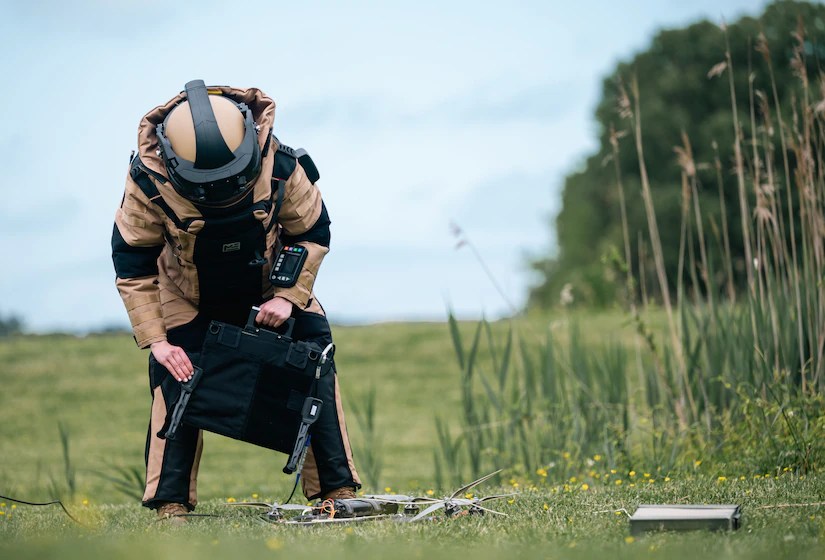

The job of ordnance disposal technicians is rapidly changing. After decades of handling prevasive ground-level threats of improvised explosive devices in Afghanistan and Iraq, disposal techs are reinventing their jobs for a new threat: drones with explosives. As they adjust, they are adding drones to their own arsenals for dealing with explosives.
Over the last two decades, Army ordnance disposal technicians were tasked with rendering more than 100,000 improvised explosive devices “safe” in Iraq and Afghanistan. But as the face of warfare changes, the threat of one-way attack unmanned aerial systems and drones strapped with munitions and explosives are becoming a topic that ordnance disposal technicians are being increasingly trained on. The Army, Air Force, Navy and Marine Corps all have specific career fields dedicated to the job, often called explosives ordnance disposal or EOD.
The Army’s 707th Ordnance Company, “Thunderbirds” and 787th Ordnance Company, “Sasquatches” recently came together for an interagency exercise at Joint Base Lewis McChord, Washington to “defeat explosive Unmanned Aerial Systems.” They trained alongside bomb and ordnance disposal experts from the FBI, Air Force, JBLM emergency services and I Corps Protection Cell.
“Although this was a training scenario, it could very easily become a real-world incident,” said 1st Lt. Luke M. Gualtieri.
EOD technicians are incorporating “lessons learned from recent combat deployments and events from around the world, incorporating drones and their delivery of explosives into their training exercises,” a spokesperson for the 20th Chemical, Biological, Radiological, Nuclear, Explosives Command said. “This includes rendering those explosives safe and their disposal.”
Subscribe to Task & Purpose today. Get the latest military news and culture in your inbox daily.
In May, a joint Air Force-NASA exercise included downed drones that EOD technicians had to make sure were cleared of explosives.
“Some of our members, they’ve done this so many times, they can’t even count. Then for some of our members that are out here, it could be their first time doing an operation like this,” Tech Sgt. Logan Keller of the 633d EOD team said in a video about the drill. “It’s super important that we’re out here to go over those lessons learned, and to ensure that when people are deployed, they have to run this scenario, that it’s not the first time that they’re seeing it.”
EOD techs are experts in chemical, biological, radiological, and nuclear materials and explosive devices. Their units work to locate and identify hazardous materials, clear areas of explosive-related contamination, conduct post-IED blast analysis and dispose of unserviceable and outdated munitions.
Their history goes back more than 80 years to when the Army began training its first enlisted Bomb Disposal Soldiers in April 1942 following the establishment of the British Bomb Squad which was created to defeat time-delayed bombs during World War II.
Using drones
At the same time that EOD specialists are tackling drones with explosives, they are also using them to help with their jobs. Robots have been used for years as a safer method of ordnance disposal, removing humans from the risk equation — but now drones are becoming another tool that’s cheaper and more plentiful. A slew of commercial companies that the Defense Department works with market their drones for reconnaissance, which includes IED and explosive material detection.
In 2021, JBLM ordnance companies received drones fitted with LiDAR systems which the commander of the 707th EOD Company, Capt. William R. Hartman said could be used to create 3D maps of surrounding terrain.
Chuck McGraw, a vice president of sales at Skydio and former Navy SEAL, promises that their drones can help says the Skydio drones can set perimeters, investigate suspicious packages, clear the scene and document evidence. The Pentagon has already cleared a number of Skydio’s drones for military and federal government use.
